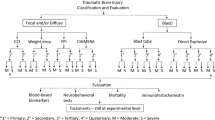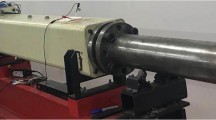Summary
Modeling traumatic brain injury represents a major challenge for neuroscientists – to represent extremely complex pathobiological processes kept under close surveillance in the most complex organ of a laboratory animal. To ensure that such models also reflect those alterations evoked by and/or associated with traumatic brain injury (TBI) in man, well-defined, graded, simple injury paradigms should be used with clear endpoints that also enable us to assess the relevance of our findings to human observations. It is of particular importance that our endpoints should harbor clinical significance, and to this end, biological markers ultimately associated with the pathological processes operant in TBI are considered the best candidate. This chapter provides protocols for relevant experimental models of TBI and clinical materials for neuroproteomic analysis.
Access this chapter
Tax calculation will be finalised at checkout
Purchases are for personal use only
Similar content being viewed by others
References
Narayan, R. K., Michel, M. E., Ansell, B., Baethmann, A., Biegon, A., Bracken, M. B., Bullock, M. R., Choi, S. C., Clifton, G. L., Contant, C. F., Coplin, W. M., Dietrich, W. D., Ghajar, J., Grady, S. M., Grossman, R. G., Hall, E. D., Heetderks, W., Hovda, D. A., Jallo, J., Katz, R. L., Knoller, N., Kochanek, P. M., Maas, A. I., Majde, J., Marion, D. W., Marmarou, A., Marshall, L. F., McIntosh, T. K., Miller, E., Mohberg, N., Muizelaar, J. P., Pitts, L. H., Quinn, P., Riesenfeld, G., Robertson, C. S., Strauss, K. I., Teasdale, G., Temkin, N., Tuma, R., Wade, C., Walker, M. D., Weinrich, M., Whyte, J., Wilberger, J., Young, A. B., and Yurkewicz, L. (2002) Clinical trials in head injury. J. Neurotrauma 19, 503–557.
Büki, A., and Povlishock, J. (2006) All roads lead to disconnection?–Traumatic axonal injury revisited. Acta Neurochir. (Wien) 148, 181–193; discussion 193–184.
Biros, M. (1991) Experimental head trauma models: a clinical perspective. Resuscitation 22, 283–293.
Cernak, I. (2005) Animal models of head trauma. NeuroRx 2, 410–422.
Kazanis, I. (2005) CNS injury research; reviewing the last decade: methodological errors and a proposal for a new strategy. Brain Res. Brain Res. Rev. 50, 377–386.
Ottens, A. K., Kobeissy, F. H., Golden, E. C., Zhang, Z., Haskins, W. E., Chen, S. S., Hayes, R. L., Wang, K. K., and Denslow, N. D. (2006) Neuroproteomics in neurotrauma. Mass Spectrom. Rev. 25, 380–408.
Pineda, J. A., Lewis, S. B., Valadka, A. B., Papa, L., Hannay, H. J., Heaton, S. C., Demery, J. A., Liu, M. C., Aikman, J. M., Akle, V., Brophy, G. M., Tepas, J. J., Wang, K. K., Robertson, C. S., and Hayes, R. L. (2007) Clinical significance of alphaII-spectrin breakdown products in cerebrospinal fluid after severe traumatic brain injury. J. Neurotrauma 24, 354–366.
Wang, K. K., Ottens, A. K., Liu, M. C., Lewis, S. B., Meegan, C., Oli, M., Tortella, F. C., and Hayes, R. L. (2005) Proteomic identification of biomarkers of traumatic brain injury. Expert. Rev. Proteomics 2, 603–614.
Farkas, O., Polgár, B., Szekeres-Barthó, J., Dóczi, T., Povlishock, J., and Büki, A. (2005) Spectrin breakdown products in the cerebrospinal fluid in severe head injury – preliminary observations. Acta Neurochir. (Wien) 147, 855–861.
Cernak, I., Vink, R., Zapple, D., Cruz, M., Ahmed, F., Chang, T., Fricke, S., and Faden, A. (2004) The pathobiology of moderate diffuse traumatic brain injury as identified using a new experimental model of injury in rats. Neurobiol. Dis. 17, 29–43.
Dixon, C., Lyeth, B., Povlishock, J., Findling, R., Hamm, R., Marmarou, A., Young, H., and Hayes, R. (1987) A fluid percussion model of experimental brain injury in the rat. J. Neurosurg. 67, 110–119.
Lighthall, J., Dixon, C., and Anderson, T. (1989) Experimental models of brain injury. J. Neurotrauma 6, 83–97.
Engelborghs, K., Verlooy, J., Van Reempts, J., Van Deuren, B., Van de Ven, M., and Borgers, M. (1998) Temporal changes in intracranial pressure in a modified experimental model of closed head injury. J. Neurosurg. 89, 796–806.
McIntosh, T., Noble, L., Andrews, B., and Faden, A. (1987) Traumatic brain injury in the rat: characterization of a midline fluid-percussion model. Cent. Nerv. Syst. Trauma 4, 119–134.
Marmarou, A., Foda, M., van den Brink, W., Campbell, J., Kita, H., and Demetriadou, K. (1994) A new model of diffuse brain injury in rats. Part I: Pathophysiology and biomechanics. J. Neurosurg. 80, 291–300.
Mendelow, A. D., and Crawford, P. J. (2005) Primary and Secondary Brain Injury, in Head Injury: Pathophysiology and Management (Reily, P. L. and Bullock, R., eds.), Hodder Arnold, London, pp. 73–92.
Reilly, P. (2001) Brain injury: the pathophysiology of the first hours. ‘Talk and Die revisited’. J. Clin. Neurosci. 8, 398–403.
Stiefel, M., Tomita, Y., and Marmarou, A. (2005) Secondary ischemia impairing the restoration of ion homeostasis following traumatic brain injury. J. Neurosurg. 103, 707–714.
Povlishock, J., and Pettus, E. (1996) Traumatically induced axonal damage: evidence for enduring changes in axolemmal permeability with associated cytoskeletal change. Acta Neurochir. Suppl. 66, 81–86.
Sawauchi, S., Marmarou, A., Beaumont, A., Signoretti, S., and Fukui, S. (2004) Acute subdural hematoma associated with diffuse brain injury and hypoxemia in the rat: effect of surgical evacuation of the hematoma. J. Neurotrauma 21, 563–573.
Koizumi, J., Yoshida, Y., Nakazawa, T., and Ooneda, G. (1986) Experimental studies of ischemic brain edema: 1. A new experimental model of cerebral embolism in rats in which recirculation can be induced in the ischemic area. Jpn. J. Stroke 8, 1–8.
Povlishock, J., Marmarou, A., McIntosh, T., Trojanowski, J., and Moroi, J. (1997) Impact acceleration injury in the rat: evidence for focal axolemmal change and related neurofilament sidearm alteration. J. Neuropathol. Exp. Neurol. 56, 347–359.
Rafols, J., Morgan, R., Kallakuri, S., and Kreipke, C. (2007) Extent of nerve cell injury in Marmarou’s model compared to other brain trauma models. Neurol. Res. 29, 348–355.
Thompson, H., Lifshitz, J., Marklund, N., Grady, M., Graham, D., Hovda, D., and McIntosh, T. (2005) Lateral fluid percussion brain injury: a 15-year review and evaluation. J. Neurotrauma 22, 42–75.
Laemmli, U. (1970) Cleavage of structural proteins during the assembly of the head of bacteriophage T4. Nature 227, 680–685.
Van Dongen, J. J., Remie, R., Rensema, J. W., and Van Wunnik, G. H. J (eds.) (1991) Manual of Microsurgery on the Laboratory Rat. Elsevier, Amsterdam.
Vink, R., Mullins, P., Temple, M., Bao, W., and Faden, A. (2001) Small shifts in craniotomy position in the lateral fluid percussion injury model are associated with differential lesion development. J. Neurotrauma 18, 839–847.
Bratton, S. L., Chestnut, R. M., Ghajar, J., McConnell Hammond, F. F., Harris, O. A., Hartl, R., Manley, G. T., Nemecek, A., Newell, D. W., Rosenthal, G., Schouten, J., Shutter, L., Timmons, S. D., Ullman, J. S., Videtta, W., Wilberger, J. E., and Wright, D. W. (2007) X. Brain oxygen monitoring and thresholds. J. Neurotrauma 24(supplement 1), S65–S70.
Henker, R. A., Brown, S. D., and Marion, D. W. (1998) Comparison of brain temperature with bladder and rectal temperatures in adults with severe head injury. Neurosurgery 42, 1071–1075.
Acknowledgments
The authors thank Orsolya Farkas M.D., Ph.D. and Peter Bukovics Ph.D. for their technical help and advice.
Author information
Authors and Affiliations
Corresponding author
Editor information
Editors and Affiliations
Rights and permissions
Copyright information
© 2009 Humana Press, a part of Springer Science+Business Media, LLC
About this protocol
Cite this protocol
Büki, A., Kövesdi, E., Pál, J., Czeiter, E. (2009). Clinical and Model Research of Neurotrauma. In: Ottens, A., Wang, K. (eds) Neuroproteomics. Methods in Molecular Biology, vol 566. Humana Press, Totowa, NJ. https://doi.org/10.1007/978-1-59745-562-6_3
Download citation
DOI: https://doi.org/10.1007/978-1-59745-562-6_3
Published:
Publisher Name: Humana Press, Totowa, NJ
Print ISBN: 978-1-934115-84-8
Online ISBN: 978-1-59745-562-6
eBook Packages: Springer Protocols




